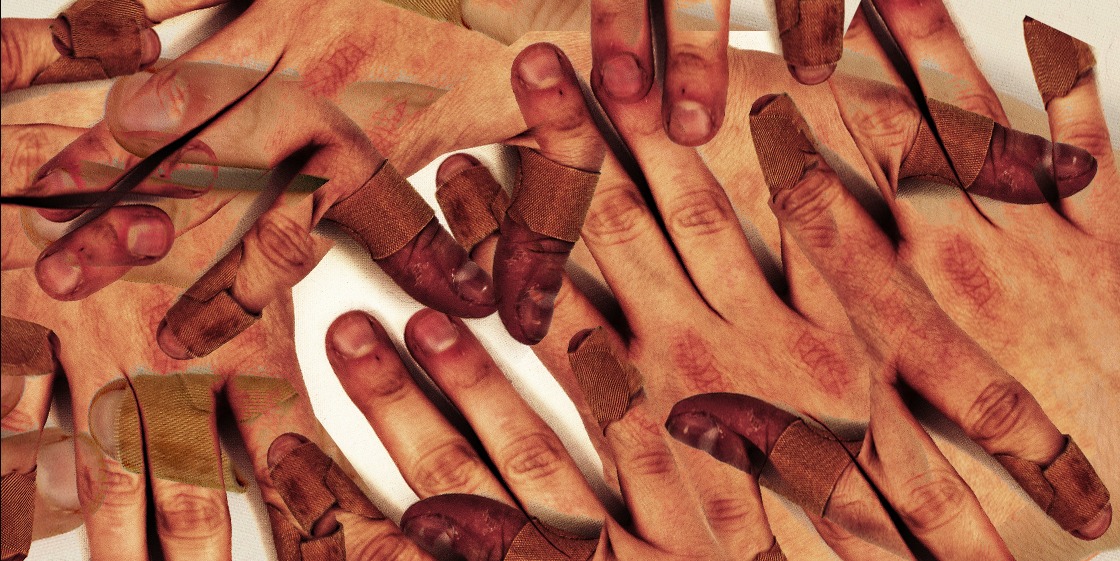Written by Kace P.
Art by Kacey P.
CW: self-harm
I stand in the bathroom, and my body becomes a war zone. In the bathroom, my fingers function like eyes, and my eyes become my enemies. When I look down my arms, a dozen scabbed-over wounds sound the alarms in my brain. A few wiry black hairs under my belly button are studded across dull pink scar tissue, taunting me from just below the surface. They need to get out, and my fingernails aren’t going to cut it.
Fuck. I went too far this time.
The tweezers are nowhere in sight, hidden by my partner after I cleaned my blood off of them weeks ago and firmly told him to put them somewhere secret where I couldn’t find them as I clutched a wad of toilet paper to my stomach to keep the blood from spilling down. I knew he could tell something was up because I had been in the bathroom for over 30 minutes, and nothing good happens in the bathroom after 30 minutes. It was on this particular night when I had dug further into my skin than ever before, eventually pulling out an entire follicle base and holding it up close to my eyes, twirling it around slowly as I inspected my trophy. Looking down at my stomach, a hole in my skin deep enough to have its own shadow stared blankly up at me. Fuck. I went too far this time.
This is the way of living for 1 in 20 people living in the United States.* From nail-biting to skin picking to hair pulling, bodily mutilation is often surprisingly common, and dramatically underrepresented in the cultural shift towards emotional wellness. There’s no doubt that acts of self-harm like cutting have gained an almost glamorous reputation through Hollywood portrayals of beautiful people desperate to feel anything. It’s a morbidly romanticized lens that distorts the reality of self-harm, something that has never been present in the less dramatic act of peeling away at your own skin with your fingernails. Even the scars of cutting can be reminiscent of the late 2000’s emo craze, where cutting scars could be shown like healed battle wounds, straight lines of raised skin indicating some level of control. The wounds left by BFRBs (Body-focused repetitive behaviors) are often much more obvious and spread across the body, little asymmetric circles and blobs covering every part of the body accessible by hands or teeth. (Note: All self-harm is a maladaptive coping mechanism, and should be neither romanticized nor shamed, only treated. Every brain is different, and it’s strongly recommended you work with a support group or therapist to relearn how to love your body as it is, scars and all, no matter how they happened.)
Reopening those wounds became a way to control my emotions, a reminder of the safety I felt when my mom was able to care for me, even when I was in situations where she couldn’t be physically present.
My struggle with BFRBs began to manifest when I was approaching puberty. It started small, with little scabs typical of reckless kids requiring a bandage and a kiss, but used as a tool of revenge by my dad after my parents’ bitter divorce. When I came home from a week at my dad’s, my mom would spend upwards of an hour treating all my wounds with the care deserved of all children, and the attention from the most important person in my life soothed me in a way I could never replicate on my own. Reopening those wounds became a way to control my emotions, a reminder of the safety I felt when my mom was able to care for me, even when I was in situations where she couldn’t be physically present. Maybe I’m reading too much into those little interactions. Still, that feeling of emotional release persists 20 years later when I absentmindedly glide my fingernails across week-old mosquito bites until I feel the rough skin gone and the warm, smooth surface of the dermis.
By the admission of the TLC Foundation for Body-Focused Repetitive Behaviors, diversity in studies of BFRBs is severely lacking and could even be considered nonexistent. Most statistical efforts are representative of predominately white upper-middle-class straight Americans, a problem shared by almost every space discussing mental illness. An unfortunate byproduct of this exclusion is a total lack of discussion in marginalized communities. It’s no secret that LGBTQ+ people are already diagnosed with mental illness at lower rates than cis and heteronormative populations, and the number goes even lower as income brackets go down. LGBTQ+ spaces have become increasingly self-aware of the lack of discussion on emotional wellness, and the conversations around BFRBs need to become a priority for groups hoping to improve the emotional wellbeing of their communities.
It’s up to each of us to start uncomfortable conversations about ugly issues, and with the support of our communities, we can begin to rebuild our temples together.
While CBT is considered the holy grail of BFRB treatment, few are able to successfully ditch the disorder, and the success rate gets even lower in marginalized social groups. However, as with all things in life, there are ways to work around BFRBs that allow sufferers to exercise some degree of control. For most folks, a mixture of therapy, medication, and mindful self-awareness brings a decrease in symptoms, and people with strong support systems see even more success.
Nobody has to suffer through the shame and pain of BFRBs alone, and bringing awareness to the disorder is the first step towards healing. When healthcare is such a financial burden in America and discrimination pulls accessible care even further away, it comes down to communities to address these problems internally. Sharing our experiences can start conversations, and conversations can start healing. Body focused repetitive behaviors don’t have to be a secret, and no community is immune to their presence. It’s up to each of us to start uncomfortable conversations about ugly issues, and with the support of our communities, we can begin to rebuild our temples together.
I still struggle every day with my BFRBs. Mindfulness tools help, medication helps, and therapy helps. But the most powerful tool we have is each other, and with a strong community, we can all work to help each other heal at our own paces.
You can find more information at The TLC Foundation for Body-Focused Repetitive Behaviors, as well as resources to help at bfrb.org.
About The Author
Kace is a queer weirdo & artist living in the midwest with their 2 dogs and partner. They’ve been involved in activist communities for over 10 years and passionately push progressive policies in their very red little town.
Follow on IG: @effervescenthoopla

